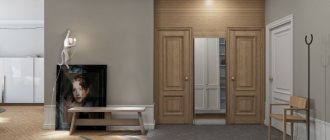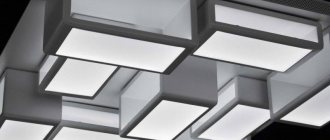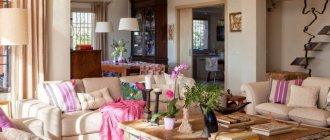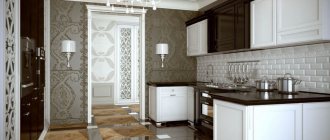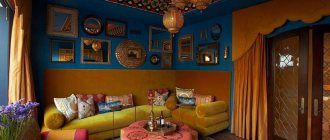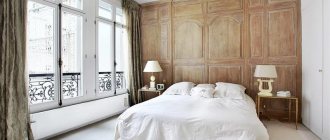English interior style
English interior style is characterized by: conservatism, good quality and elegance. Natural finishing materials, comfortable and high-quality furniture are welcome: leather armchairs, Chesterfield sofa, wicker furniture. Lots of textiles and accessories. Mandatory attributes are a fireplace and a library... Read more about the English style in the interior →
Living room
By choosing to decorate your living room in an ethnic style, you risk making your largest room in the house expressive, bright and unique. To give the room warmth and comfort, you need to choose natural high-quality materials, for example, wood, stone.
Depending on the direction you choose, you need to harmoniously combine pieces of furniture, decor and accessories in one key. It is best to choose furniture from light wood. Wicker chairs and sofas will fit perfectly into the living room. Bright pillows with ornaments will add national flavor.
The floor can be covered with a beautiful carpet. Mirrors, lamps, and gold-plated accessories will fit perfectly into the interior. Dried herbs, bamboo, real tropical palm trees, panels with hieroglyphs, ceramics of various shapes and textures will decorate your home and make it unique.
African interior style
An African-style interior is usually quite bright and dynamic, but also cozy and warm. Naturalness is one of the conceptual features of the African style, which is why natural materials are predominantly used in decoration. The interior decoration is distinguished by an abundance of textiles and accessories... Read more about African style in the interior →
Where does style fit in?
- In private homes, ethnic styling is more appropriate than anywhere else. There is enough space here to let your imagination run wild. It’s great when not just one room of the house, but the entire house is decorated in a given style. Thus, when entering such a house, a person is completely immersed in the culture of the chosen country.
- Ethnic style can also be used in a city apartment. However, here the choice of a specific type of direction needs to be approached more carefully. It all depends on the size of the apartment and the number of rooms. Some subspecies of ethno style will take root only in very spacious rooms, others will look great even in the smallest rooms.
- Ethnic style looks very good in themed restaurants, cafes and bars. A certain interior design helps guests get acquainted with the culture of the country whose cuisine they have chosen. Such a successful move makes visitors return to the restaurant again and again.
- And, finally, the ethno style will fit well into any thematic establishment, for example, a travel agency, a souvenir shop, a spa salon, and so on.
Related article: How to make tiles with your own hands - master class on making tiles
Japanese interior style
When decorating an interior in Japanese style, the main focus is on creating an atmosphere that will ensure harmony of spirit and body. The combination of light and dark shades, characteristic of the Japanese monastery, pursues not only an aesthetic goal, but corresponds to Japanese philosophy with its doctrine of the unity of yin and yang. Furniture, textiles, light and decor are used rationally, such an interior is not loaded with “extra” things that do not carry a semantic load... Read more about Japanese style in the interior →
+ See also:
- › All interior styles - list with photos
- › Modern interior styles
- › Classic interior styles
Ethnic interior styles.
Style Guide: Ethnic interior styles
Interior style is a set of details and features that distinguish different directions in finishing, design, furnishing and decoration of premises.
Styles appeared gradually: some became a reflection of eras, others were formed depending on the characteristics of national culture, and others determined modern trends in art. To help you easily navigate the design and decoration of a room, Open Village has prepared a real Style Guide that will easily and quickly introduce you to the main trends in the interior.
Interior styles are divided into the following groups:
1. Historical 2. Ethnic 3. Modern
We have already told you about historical interior styles, now it’s time to tell you about ethnic ones.
An ethnic-style interior carries the national characteristics of a particular country, and its originality is determined by the way of life and way of life of the people. Geographical location, climatic conditions, historical events, cultural traditions - all these are factors in the formation of ethnic style. Similarity is achieved by using similar colors, materials and decorative elements. Quite often, when recreating an ethnic style, the interior characteristic of a particular people in ancient times is taken as a standard (for example, the Egyptian style implies the interior of Ancient Egypt).
When decorating the interior of such an interior, there are three solutions that determine the intensity of ethnic motifs:
1) Authentic ethnicity
This solution implies the most accurate recreation of the interior. At the same time, it is worth paying attention not only to the decoration, but also to the finishing of the room.
2) Ethnic mix
As you might guess, mix means mixing attributes of different trends within an ethnic style. In this case, you should be extremely careful, because there is every chance of overdoing it and turning the interior into complete bad taste.
3) Ethnic accents
This is the most popular and easiest option to implement. Ethnic elements (textiles, furniture) will breathe life into any interior, while the decoration of the room should be neutral.
Main directions of ethnic style:
African style
This direction of ethnic style originated at the beginning of the 20th century. It is characterized by a natural color scheme: mainly yellow, red, orange and brown colors with earthy undertones, as well as the presence of specific accessories such as wild animal skins, ritual masks, black figurines and woven woolen carpets. When creating an African interior, you should pay attention to rattan and solid wood furniture, natural fabrics with national patterns, as well as vases and ivory figurines.
Photo: Pinterest
Photo: Pinterest
Photo: Pinterest
Japanese style
It is difficult to convey the original interior of the inhabitants of the country of the ascendant, but it is possible. One of the features of the Japanese style is the division of space into “functional zones” using screens, curtains, sliding partitions and differences in floor level. The furniture is low, made of light wood or bamboo. The colors are natural - all shades of beige, black, milky. Also use decorative elements, such as bone or wood figurines (netsuke), scrolls with hieroglyphs (kakemono), bamboo or straw mats, bonsai, ikebana, vases, lamps and fine porcelain.
Photo: Pinterest
Photo: Pinterest
Photo: Pinterest
English style
A fireplace, a bookcase and a chair with ears (“wing chair”) - these are the three pillars of the British interior. Abundant use of wood (oak, mahogany, walnut), leather upholstered furniture (chesterfield sofa, armchairs, ottomans) and textiles (thick curtains, lambrequins) is mandatory. Much attention is paid to patterns, large checks and floral prints. Accessories such as paintings, mirrors in massive frames, vases, rugs, family heirlooms on the mantelpiece will complement the English style. Antiques are welcome.
Photo: Pinterest
Photo: Pinterest
Photo: Pinterest
Egyptian style
The ancestor of interior history is characterized by the presence of geometric patterns and ancient Egyptian symbolism, as well as the presence of arches, columns and pylons. Stone and mosaic are used in the decoration, and door and window openings should be made lancet. When recreating such an interior, preference is given to colors such as gold, beige, white, sand and ivory. The finished look of the interior will be given by various accessories: figurines of ancient Egyptian gods, papyri with hieroglyphs, floor vases, outlines of the solar disk and mats.
Photo: Pinterest
Photo: Pinterest
Photo: Pinterest
American style or country
Country style will help make your room the most comfortable space that will be reminiscent of a country cottage. The first step is to abandon all modern materials, giving preference to stone (floor laying, wall cladding, fireplace area design) and wood (ceiling beams, furniture, flooring). The country color palette is mostly light, natural shades. Wallpaper with floral and plant prints, decorative plaster, ceramic tiles, wicker or forged furniture are welcome. You should also pay attention to accessories such as baskets, napkins, porcelain plates, fabric lampshades, tablecloths.
Photo: Pinterest
Photo: Pinterest
Photo: Pinterest
Indian style
When decorating a space in Indian style, you should remember that the basis of this style is carved furniture, national ornaments, bronze inlays, colored stones and gold objects. Also, to accurately recreate the atmosphere of an Indian home, you will need decorative elements made of ivory, forged metal and teak wood; Buddha images; door bells and pendants. The main colors of this interior are orange, turquoise, crimson, yellow.
Photo: Pinterest
Photo: Pinterest
Photo: Pinterest
Chinese style
There is a misconception that Chinese and Japanese interiors are similar, but in fact this is not entirely true. The restraint of the Japanese will not tolerate so many intricate carvings, national images (mainly dragons, elephants, pheasants, plants), as well as inlays of wood, mother-of-pearl and copper. Despite the abundance of decor, in terms of furniture arrangement, Chinese interior follows some principles of minimalism (this is what makes it similar to Japanese). A mandatory element of such an interior is a low table for tea ceremonies, which should be placed in the middle of the room, surrounded by a sofa and armchairs. Decorative screens, bamboo products, Chinese porcelain and dark wood furniture are also welcome.
Photo: Pinterest
Photo: Pinterest
Photo: Pinterest
Scandinavian style
Plank floors, wooden ceiling beams and windows, freedom from unnecessary details and maximum light - all these are features of the Scandinavian style. The decor is quite restrained: sconces, colorful pillows, indoor plants, abstract paintings. White color is an indispensable companion of the Scandinavian interior, other colors are clean and cool - blue, light gray, blue, green-beige. To imagine Scandinavian interior style furniture, it is enough to recall most of the IKEA assortment - frame chairs, minimalist shelving, modular sofas, massive tables, eclectic floor lamps.
Photo: Pinterest
Photo: Pinterest
Photo: Pinterest
Moroccan style
The main feature of the Moroccan interior is the combination of warm, sun-soaked shades (gold, terracotta) with clean, bright colors (ultramarine and emerald). Moroccan furniture is quite unique: an abundance of details and draperies, a pronounced texture of textiles (velvet, organza, silk are mainly used) and the presence of embroidery. Much attention is paid to auxiliary interior items such as ottomans, cabinets, benches. This interior will be complemented by traditional Moroccan tiles with complex geometric patterns.
Photo: Pinterest
Photo: Pinterest
Photo: Pinterest
French style or Provence
This style bears the name of a picturesque region in the south of France, where in the 17th century representatives of the bourgeoisie, tired of the bustle of the city, began to settle en masse. The interior in the Provence style can be described as homely luxury or elegant comfort. Warm pastel colors, floral patterns, wooden beam ceilings, organza draperies and aged oak furniture are the main features of French country.
Photo: Pinterest
Photo: Pinterest
Photo: Pinterest
Features of wall color decoration
When decorating rooms, shades of natural, restrained tones will be preferable. Golden yellow, terracotta, pale green, olive colors, designed in accordance with belonging to a particular nationality, will be a win-win.
For example, a passionate Latin mood can be supported by using a variety of red palettes. The spirit of Africa is revived with the help of ocher and sandy shades, but the captivating charm of an Arabian fairy tale is recreated through a combination of white and blue, gold and red, turquoise and yellow.
It is important not to forget about the texture of the walls and covering the floor with natural materials, such as bamboo, natural stone, mat, reeds. Both real wood and laminate will look great on the floors.
To further harmonize the space, miniature fountains will fit in. Also non-trivial will be the combination of various exotic plants installed on the floor, walls, windows and the murmur of water in water slides.
As for decorative items, you can perfectly complement the decoration with carpets and tapestries with folk patterns, figurines and masks that will embody the sensual fantasies of your home atmosphere.
